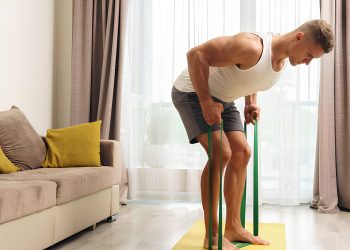If you want to build cannonball delts at home with limited equipment, we highly recommend the shoulder press (with bands). Training bands can provide as much resistance as you need without the cost of high-dollar freeweights or needing to lug around heavy dumbbells (not without its drawbacks though). You can also use them in many different ways to target all heads of the deltoid muscles.
Learn about the benefits of band presses, exercise tips, best variations and alternatives, sets and reps, and programming.
How To Do Shoulder Presses (With Band)
If you want to get the most benefit from training with bands then you need to pay close attention to detail. Make sure that when you step on or secure the bands under a bench, that both sides are even. Otherwise you’ll be training one side harder than the other and that affects strength symmetry.
Grab your band of choice and let’s perform the shoulder press step-by-step.
Step 1: Setting up
The difference between training with freeweights and bands is that the latter requires a little more setup time. You need to find the exact center of the band, secure it down with your foot or both feet and compare both sides without tension in the bands.
If you want less tension, use one foot. For more resistance, step on the band with two feet. The wider your stance, the more tension will be in the bands, and consequently, the harder the workout.
Level Up Your Fitness: Join our 💪 strong community in Fitness Volt Newsletter. Get daily inspiration, expert-backed workouts, nutrition tips, the latest in strength sports, and the support you need to reach your goals. Subscribe for free!
Note: Bands designed like the ones used in the video example below allow for a much easier and more comfortable setup than the common long single, thick tube-shaped bands.
Step 2: Getting into position
To target all heads of the shoulder muscles, you want to make sure you have the right setup.
- Grip the handles tight in your hands then bring the bands behind your arms in an overhead press position palms facing away from you and upper arms parallel to the floor. Maintain a strong, upright posture and tense core.
Step 3: The press and rep
- From here, you’ll extend your arms overhead into a press. Keep your hands directly above your elbows. For the negatives or lowering phase, slowly drop your elbows down until your upper arms are parallel to the ground. You’ve completed one rep!
Perform the desired number of reps, take a short 45-second rest break and then repeat for two to three more sets.
Watch the video provided below for a demonstration of shoulder presses (with band).
Pro tip: Use a wider than shoulder width grip to activate more of the rear deltoids.
Why Do Shoulder Presses (With band)
What are the pros of banded shoulder presses?
Oh so convenient and effective!
Training bands have a unique purpose that other workout tools cannot fulfill. Resistance tubing is lightweight, durable, and comes in many different resistance levels. You can fit bands in a small bag or easily bring them to a gym. Not to mention, for a few bucks you can have one of the most versatile training tools ever created. You can get a workout equivalent to using free weights with a compact, quality piece of rubber tubing.
Too easy? No problem!
If you find that the shoulder press with resistance bands becomes too easy, you can either add another band (although you can only fit so many handles in your grip) or buy a multi-band set that comes with attachments (the best option for advanced exercisers).
Related article: 60 Best Shoulder Isolation Exercises For Bigger and Peeled Deltoids
Drawbacks
Are there drawbacks?
Varied resistance
The one disadvantage of using bands is that the resistance is not the same from top to bottom. Free weights are the same weight throughout a rep but a band starts off with no tension and it increases as it stretches. That’s why it’s important to choose the right band resistance and setup.
Uneven sides
Whether you do band presses standing or seated, a common mistake is not making both sides even. As a result, you may develop left to right strength imbalance. This is another drawback of using bands. Although if you pay attention, it’s a non-issue.
Common Mistakes
What are some things to avoid when performing shoulder presses with bands?
Not taking your time
Again, you want to make sure the bands are setup correctly before you start knocking out repetitions. Dumbbells and machines are much more straightforward because they’re fixed weight systems. However, you need to double and triple check your foot and hand placement with certain bands especially. Otherwise, you’ll have an uneven workout and that makes a difference in your results.
Protect your junk
The suckiest thing that can happen when training with bands is for them to get loose and snap you in the face or areas we won’t mention. That’s why it’s very important to stand on the bands with the center of your foot. Keeping your balance is also important here too because one slip up and you could be in a pain.
6 Shoulder Press (With Band) Variations
There are literally so many shoulder press with resistance bands variations But we couldn’t possibly list them all. These are the ones we really like.
1. Lying one arm shoulder press (Best Variation)
If you have a loop band, this is our favorite variation because it solves a common problem with standing overhand band presses. Oftentimes the band is too light or heavy at the beginning of a press making them much less effective or even impossible to do. That’s because there’s either too little or too much stretch or travel in the band.
Level Up Your Fitness: Join our 💪 strong community in Fitness Volt Newsletter. Get daily inspiration, expert-backed workouts, nutrition tips, the latest in strength sports, and the support you need to reach your goals. Subscribe for free!
This version allows you to find the perfect balance of elasticity in the band to provide the desired resistance at both ends.
To do it:
- Sit on the floor and wrap one end of the loop band under either foot in the center to keep it secure.
- Grab the other end with the same side hand. For example, if you wrapped the band around your left foot, then you’ll press with your left arm.
- Lie on your back and bring your working arm into a front rack position with the band in hand. In simpler terms, hold the band at your shoulder.
- Slightly bend at the knee to loosen tension in the band and try to press the band overhead to check the resistance before you begin a set. You want to have enough resistance at the beginning of each rep but not too much that you cannot press the arm straight overhead.
- Complete the desired number of reps, then switch sides and repeat.
Check the 1:35 mark to watch a detailed explanation and demonstration of this band shoulder press variation.
2. Seated shoulder press (with band)
Doing the same exercise seated has its advantages over the standing variation. You can use a training bench or chair that locks the band in place underneath and this allows you to switch your positioning. For example, you can press directly overhead or do more of a front press which is possible because the band will be anchor by the front legs of the chair or bench.
The one drawback is that you may not create as much tension in the band at the bottom range of the pressing movement. Then again, the standing variation may provide too much resistance. Typically both variation will work with the right bands.
3. Kneeling shoulder press
The kneeling variation can work better for heavy bands because it requires less range of motion. Therefore, the band doesn’t have to stretch as far which is more challenging standing (using a heavy resistance band).
To do it, get in a tall kneeling position and step your knees evenly onto the bottom part of the band to secure it to the floor. Grip the top end about shoulder-width apart in the front rack position and then perform overhead presses.
4. Bilateral loop band
You have the bands with convenient handles attached to the end that more easily allow you train each arm unilaterally (one side at a time), and then you have loop bands that are essentially a giant rubber band. You can do single arm presses with either, however, the loop bands are better if you wat to replicate using barbell.
You can do them standing, seated or kneeling. But you can also use the loop bands for one arm presses too.
5. Cable shoulder press
If you want a close variation to band presses, try the shoulder press using cables. It’s easier to adjust the resistance using a weight stack and the weight stays the same in the bottom and top of each rep unlike bands. If you prefer to do them seated, you can adjust the height of the bench, allowing you to train the delts from various angles.
6. Dumbbell shoulder press
Dumbbells are a more consistent training tool than bands (doesn’t necessarily make it totally superior). That’s because when you start at the bottom there’s no change in the resistance at any point during the repetition. The only disadvantage is that lifting heavy dumbbells unto place is harder than doing it with bands. However, because you have to stabilize the weight, you’ll benefit from overall strength gains.
Sets and Reps
Treat band presses the same you would a freeweight or machine press. It’s not a toning tool but rather something you can use to make strength progress and muscular gains. While bands should not be your primary strength building tool, challenge yourself and use a variety of rep ranges to see results.
Below are the recommended rep ranges for specific goals.
- Strength: 3-5 reps
- Muscle growth: 6-12 reps
- Muscle endurance: 15-25+ reps
Choosing The Right Resistance Band
There are so many different resistance bands on the market it’ll make your head spin. The good news though, is that you won’t have a problem finding a good quality rubber training tube or a full set with different resistance level and attachments for an affordable price.
Tubing typically comes in the following resistance ratings – extra light, light, medium, heavy, and extra heavy. We even included the resistance recommendations based on experience level. Note: this will vary because experience level does not necessarily equate to strength ability.
Band recommendations based on training experience:
- Beginners – Extra light to medium
- Intermediate – Medium to heavy
- Advanced – Heavy to extra heavy
Handles vs loops: Is One Better Than The Other?
The two common types of resistance bands are the ones shaped like tubes that have handles and ones that look like giant rubber bands. You can use either one and they’re equally as effective, however, depending on your training goals you may want to use one over the other. But keep in mind, you can do all the same things with both types of bands.
Handles
- Better for unilateral training (two sides moving separately)
- Easier to change the resistance (attachments)
- More user friendly for the average exerciser
- More versatile overall
Loop
- Better for bilateral training (two sides moving together)
- Best for serious lifters
- Can better replicate the barbell press
Related: 13 Best Resistance Bands Reviewed for 2024
Muscles Worked

Shoulder presses and its variations are compound exercises which means they not only work deltoids but several other muscles are involved. We’ve included brief descriptions of all the muscles you’re training during this movement.
- Deltoids anterior – One of the three larger muscles in the glenohumeral joint, the anterior head of the deltoids is located on the front side of the body and it mainly lifts the arm forward also known as flexion. It’s usually well developed in a trained individuals because it’s involved in all pressing movements.
- Deltoid lateral – A very important muscle aesthetically, the deltoid lateral is the outermost shoulder head that gives you that rounded shape and width to the upper body. Exercises like dumbbell lateral raises are the best for brining out its shape but what is its function? To abduct or lift the arm up from a 15-100 degree position like you’d do during the aformentioned exercise.
- Pectoralis major clavicular head – The upper section of chest fibers the flexes the extended arm. Any pressing exercise will activate these muscles.
- Serratus Anterior – Occupying the area between the pectoralis and latissimus dorsi muscles, serratus anterior, a fan shaped muscle protracts the arms (pulls them forward) and upwardly rotates the shoulder blades to raise the arms overhead with help from the trapezius.
- Triceps brachii – The biggest upper arm muscle between the elbows and shoulders, your triceps have three heads – lateral, medial and long – all that work together to extend the elbows like when you press or hold up your own weight.
- Core/abs – The core is a group of individual muscles that all have a different role. For example, the abs allow us to crunch while the obliques help us to twist side to side and the back extensors make us upright from bentover. For overhead presses, the deep abdominal muscles work to keep our torsos rigid and strong to handle the resistance.
Bottom Line
The shoulders press (with band) is one of the best exercises to slap on muscle and increase your overhead pressing strength without using weights or machines. It even has an advantage over bodyweight deltoid exercises because you can easily attach another band or adjust your body position to add more resistance.
But make sure to avoid the common mistakes that many exercisers make when training with bands and they’ll be one of the best tools that you can add in your arsenal.
Interested in measuring your progress? Check out our strength standards for Seated Shoulder Press, Shoulder Press, Dumbbell Lateral Raise, and more.








